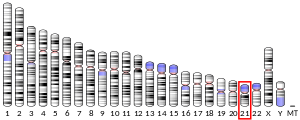| CLDN14 | |||||||||||||||||||||||||||||||||||||||||||||||||||
|---|---|---|---|---|---|---|---|---|---|---|---|---|---|---|---|---|---|---|---|---|---|---|---|---|---|---|---|---|---|---|---|---|---|---|---|---|---|---|---|---|---|---|---|---|---|---|---|---|---|---|---|
| Identifiers | |||||||||||||||||||||||||||||||||||||||||||||||||||
| Aliases | CLDN14, DFNB29, claudin 14 | ||||||||||||||||||||||||||||||||||||||||||||||||||
| External IDs | OMIM: 605608; MGI: 1860425; HomoloGene: 8115; GeneCards: CLDN14; OMA:CLDN14 - orthologs | ||||||||||||||||||||||||||||||||||||||||||||||||||
| |||||||||||||||||||||||||||||||||||||||||||||||||||
| |||||||||||||||||||||||||||||||||||||||||||||||||||
| |||||||||||||||||||||||||||||||||||||||||||||||||||
| |||||||||||||||||||||||||||||||||||||||||||||||||||
| |||||||||||||||||||||||||||||||||||||||||||||||||||
| Wikidata | |||||||||||||||||||||||||||||||||||||||||||||||||||
| |||||||||||||||||||||||||||||||||||||||||||||||||||
Claudin-14 is a protein that in humans is encoded by the CLDN14 gene. It belongs to a related family of proteins called claudins.
The protein encoded by CLDN14 is an integral membrane protein and a component of tight junctions, one mode of cell-to-cell adhesion in epithelial or endothelial cell sheets. Tight junctions form continuous seals around cells and serve as a physical barrier to prevent solutes and water from passing freely through the paracellular space.
These junctions are composed of sets of continuous networking protein strands in the outer surface of the cell membrane, with complementary grooves in the inwardly facing extracytoplasmic leaflet. The CLDN14 protein also binds to WW domain of Yes-associated protein.
Defects in CLDN14 are the cause of an autosomal recessive form of nonsyndromic sensorineural deafness. Two transcript variants encoding the same protein have been found for this gene.
There are also suggestions that CLDN14 plays a role in tumour angiogenesis (blood vessel formation), as deletion of a single copy of this gene leads to tight junction defects and leaky blood vessels in a mouse model.
Polymorphisms in CLDN14 are associated with kidney stone risk. It is likely that additional roles for claudins in the pathogenesis of other types of kidney diseases have yet to be uncovered.
See also
- Nonsyndromic deafness (DFNB29)
References
- ^ GRCh38: Ensembl release 89: ENSG00000159261 – Ensembl, May 2017
- ^ GRCm38: Ensembl release 89: ENSMUSG00000047109 – Ensembl, May 2017
- "Human PubMed Reference:". National Center for Biotechnology Information, U.S. National Library of Medicine.
- "Mouse PubMed Reference:". National Center for Biotechnology Information, U.S. National Library of Medicine.
- Wilcox ER, Burton QL, Naz S, Riazuddin S, Smith TN, Ploplis B, Belyantseva I, Ben-Yosef T, Liburd NA, Morell RJ, Kachar B, Wu DK, Griffith AJ, Riazuddin S, Friedman TB (Feb 2001). "Mutations in the gene encoding tight junction claudin-14 cause autosomal recessive deafness DFNB29". Cell. 104 (1): 165–72. doi:10.1016/S0092-8674(01)00200-8. PMID 11163249. S2CID 6346705.
- ^ "Entrez Gene: CLDN14 claudin 14".
- Baker M, Reynolds LE, Robinson SD, Lees DM, Parsons M, Elia G, et al. (2013). "Stromal Claudin14-Heterozygosity, but Not Deletion, Increases Tumour Blood Leakage without Affecting Tumour Growth". PLOS ONE. 8 (5): e62516. Bibcode:2013PLoSO...862516B. doi:10.1371/journal.pone.0062516. PMC 3652830. PMID 23675413.
External links
- Human CLDN14 genome location and CLDN14 gene details page in the UCSC Genome Browser.
Further reading
- Kniesel U, Wolburg H (2000). "Tight junctions of the blood–brain barrier". Cell. Mol. Neurobiol. 20 (1): 57–76. doi:10.1023/A:1006995910836. PMID 10690502. S2CID 26473781.
- Heiskala M, Peterson PA, Yang Y (2001). "The roles of claudin superfamily proteins in paracellular transport". Traffic. 2 (2): 93–8. doi:10.1034/j.1600-0854.2001.020203.x. PMID 11247307. S2CID 12132159.
- Tsukita S, Furuse M, Itoh M (2001). "Multifunctional strands in tight junctions". Nat. Rev. Mol. Cell Biol. 2 (4): 285–93. doi:10.1038/35067088. PMID 11283726. S2CID 36524601.
- Tsukita S, Furuse M (2003). "Claudin-based barrier in simple and stratified cellular sheets". Curr. Opin. Cell Biol. 14 (5): 531–6. doi:10.1016/S0955-0674(02)00362-9. PMID 12231346.
- González-Mariscal L, Betanzos A, Nava P, Jaramillo BE (2003). "Tight junction proteins". Prog. Biophys. Mol. Biol. 81 (1): 1–44. doi:10.1016/S0079-6107(02)00037-8. PMID 12475568.
- Chen HI, Sudol M (1995). "The WW domain of Yes-associated protein binds a proline-rich ligand that differs from the consensus established for Src homology 3-binding modules". Proc. Natl. Acad. Sci. U.S.A. 92 (17): 7819–23. Bibcode:1995PNAS...92.7819C. doi:10.1073/pnas.92.17.7819. PMC 41237. PMID 7644498.
- Hattori M, Fujiyama A, Taylor TD, et al. (2000). "The DNA sequence of human chromosome 21". Nature. 405 (6784): 311–9. Bibcode:2000Natur.405..311H. doi:10.1038/35012518. PMID 10830953.
- Strausberg RL, Feingold EA, Grouse LH, et al. (2003). "Generation and initial analysis of more than 15,000 full-length human and mouse cDNA sequences". Proc. Natl. Acad. Sci. U.S.A. 99 (26): 16899–903. Bibcode:2002PNAS...9916899M. doi:10.1073/pnas.242603899. PMC 139241. PMID 12477932.
- Uyguner O, Emiroglu M, Uzumcu A, et al. (2004). "Frequencies of gap- and tight-junction mutations in Turkish families with autosomal-recessive non-syndromic hearing loss". Clin. Genet. 64 (1): 65–9. doi:10.1034/j.1399-0004.2003.00101.x. PMID 12791041. S2CID 29823828.
- Clark HF, Gurney AL, Abaya E, et al. (2003). "The Secreted Protein Discovery Initiative (SPDI), a Large-Scale Effort to Identify Novel Human Secreted and Transmembrane Proteins: A Bioinformatics Assessment". Genome Res. 13 (10): 2265–70. doi:10.1101/gr.1293003. PMC 403697. PMID 12975309.
- Gerhard DS, Wagner L, Feingold EA, et al. (2004). "The Status, Quality, and Expansion of the NIH Full-Length cDNA Project: The Mammalian Gene Collection (MGC)". Genome Res. 14 (10B): 2121–7. doi:10.1101/gr.2596504. PMC 528928. PMID 15489334.
- Van Itallie CM, Gambling TM, Carson JL, Anderson JM (2005). "Palmitoylation of claudins is required for efficient tight-junction localization". J. Cell Sci. 118 (Pt 7): 1427–36. doi:10.1242/jcs.01735. PMID 15769849.
- Wattenhofer M, Reymond A, Falciola V, et al. (2006). "Different mechanisms preclude mutant CLDN14 proteins from forming tight junctions in vitro". Hum. Mutat. 25 (6): 543–9. doi:10.1002/humu.20172. PMID 15880785. S2CID 27476200.
- Hu YH, Warnatz HJ, Vanhecke D, et al. (2006). "Cell array-based intracellular localization screening reveals novel functional features of human chromosome 21 proteins". BMC Genomics. 7: 155. doi:10.1186/1471-2164-7-155. PMC 1526728. PMID 16780588.
- Liu F, Koval M, Ranganathan S, Fanayan S, Hancock WS, Lundberg EK, Beavis RC, Lane L, Duek P, McQuade L, Kelleher NL, Baker MS (2015). "A systems proteomics view of the endogenous human claudin protein family". J Proteome Res. 15 (2): 339–359. doi:10.1021/acs.jproteome.5b00769. PMC 4777318. PMID 26680015.
- Sticky cells, blood vessels and cancer – the paradox of Claudin-14 - Marianne Baker, Cancer Research UK Science Update blog, 14 June 2013
This article on a gene on human chromosome 21 is a stub. You can help Misplaced Pages by expanding it. |




